Magento 2 Roadmap (2020)

Since there is no official Magento 2 roadmap, we’ve decided to create our own. Below, you will find Magento release roadmap that contains plans and features that have been already mentioned by the Magento team or other trusted sources. We will try to gather all the latest information about Magento 2 updates here, so get ready to see how the popular ecommerce platform will change in the nearest future.

In the following few chapters, you will find the most probable features that tend to become both minor and major Magento 2 updates for 202. Next, the article contains Magento 2 Roadmaps for the previous years.
Table of contents
Magento 2 Roadmap 2020
Magento 2.4
Below, you can see enhancements and features that may become a part of Magento 2.4.
Magento 2.4 Update Directions
After exploring all possible rumors regarding Magento 2.4, we think that it will get improvements in:
- B2B (PWA for B2B and B2C);
- GraphQL;
- Asynchronous import;
- Integration with Adobe products;
- Magento 2 Cloud-specific enhancements;
- Page Builder;
- Magento 2 inventory (MSI);
- Better admin.
Magento 2 GraphQL
is going to become a primary API not only in the Magento 2 frontend development but also in other processes, replacing REST and SOAP. It already powers the Magento 2 PWA Studio and is going to gain more impact on the platform!
The following features for Magento 2.3.x and 2.4 have been announced:
- Support for checkout and payments with mutations;
- GraphQL API for various frontend processes and areas: checkout, orders, customer account;
- GraphQL framework improvements.
Here at Firebear, we think that Magento is preparing the full GraphQL coverage for all Magento 2.4 editions: Open Source, Commerce, and Cloud. Check the official Magento 2 GraphQL backlog for further information: .
Asynchronous Import
Bulk API and asynchronous import are already a part of Magento 2 Commerce. However, we expect that this functionality will be exceeded in Magento 2.4, improving both import and export features. Magento may replace the current Import solution with the Asynchronous Import module, delivering the following features to the Magento 2 backend:
- Support for multiple file formats;
- Use of File UUID with custom parameters;
- Even the biggest data file is split into multiple messages and sent via Bulk API;
- You can send requests and get the status of import back.
If you need to import data with top-notch performance, automate this process, work with numerous file formats and archives in your Magento 2.3 backend or older versions, check our extension – Improved Import & Export for Magento 2. It already includes the features mentioned above as well as adds a bunch of new functionalities.
Adobe Integration
Of course, we should also expect integration with other Adobe products:
- Adobe Stock. Previously, it was rumored that Magento 2.4 would be integrated with Adobe Stock. However, this integration was introduced in Magento 2.3.4.
- Magento 2.4 & CIF. More tight integration between Magento 2.4 and Commerce Integration Framework (CIF) is also expected. It should provide a more powerful and personalized omnichannel shopping, simplifying Magento 2.4 integrations with other Adobe products. Check the project here: .
- Adobe Experience Platform. There is a community project that spans both Magento and Launch, enabling integration with Adobe Analytics and Adobe Target. Something similar may appear in Magento 2.4, providing merchants with in-depth customer insights and the ability to deliver more personalized experiences.
Headless Magento 2.4
When it comes to the headless approach to Magento, 2.4 should improve the developer experience with the official PWA tool aimed at developers. As for merchants, the company plans to offer a highly flexible infrastructure with continuous integration and delivery processes. Thus, merchants of all sizes will get the ability to deploy the features they want. At the same time, the time necessary to add them to production will be dramatically reduced. Follow this link to read the full article: .
Magento 2 MSI Roadmap
Magento 2.4 should also introduce various MSI improvements in Magento 2.4, enabling such features as stock management for several locations with no third-party extensions (like it is possible now). The official MSI roadmap includes the following improvements and fixes:
- Inventory Stock Index improvements;
- Extension Attributes class generation improvements;
- Slow Inventory save (based on Web API);
- Unique Stock Name field integration;
- Mass action improvements (‘Select all’);
- Inventory deduction compensation;
- In-object caching improvements (Salability status);
- Better reservations clean up;
- Enhanced low stock reports;
- More precise calculations for virtual or downloadable products.
Besides, you can find new features and integrations for B2B, PWA, and GraphQL API in the Magento 2 MSI Roadmap. Check it here: .
Security
Magento 2.3.4 already introduced the ability to install security patches separately. To increase the platform’s security even more, Adobe may present an auto-patcher. As a result, all security updates will be installed automatically. We expect this critical enhancement will become a part of Magento 2.4.
Functional Testing Framework
Various updates and enhancements related to the platform’s functional testing framework (MFTF) are also listed in the official Magento 2 roadmap. We think that 2.4 will introduce essential improvements in this area. You can find the roadmap here: .
Official Coding Standard
Of course, the official coding standard will be improved with all further releases of Magento 2. You can find the proof here: .
Community Impact
The community impact on Magento 2 is always rising. And, as a developer, you always have a chance to make our favorite e-commerce platform better. You can participate in every Wednesday, 10:30 am CST/CDT.
The ecosystem lets you leverage a repository created by the initiative of Magento architects to discuss with the Magento community any open questions around Magento 2 architecture. Although nobody guarantees that approved changes will be delivered into the Magento codebase, you can try to propose your vision. For further information, follow this link: .
Magento 2 PWA Roadmap
Although the Magento 2 PWA Studio is a developer tool that exists separately from the platform, we’d like to draw more attention to it. The reason is obvious: it illustrates the future of e-commerce. And it is the official instrument for creating headless online storefronts on top of Magento 2. How could we stay aside?
PWA gradually conquers the e-commerce market, introducing the leading way to create online storefronts. It combines the best features of native apps and the web. As for Magento 2.4, it may introduce more in-depth integration with the concept. While the previous year featured improvements focused on the developer experience, 2020 will provide us with enhancements to the shopper experience. The current priorities for Q1-Q2 2020 include:
- new Venia features;
- existing experience optimization.
It is also necessary to mention, the Venia theme and the entire PWA approach is mobile-oriented. However, the new improvements will enhance the existing desktop experience. The MAgento 2 PWA Studio team is also going to introduce a new, more extensible framework. It will simplify the customization and development of third-party extensions on PWA Studio. Other goals are to improve quality, scalability, and performance.
When it comes to the renewed developer experience, we should get the following PWA enhancements in Magento 2.4 and further version:
- Release of new versions;
- Extra extensibility;
- Support for marketplace extensions;
- Introduction of SEO/SEM tooling;
- Performance improvements;
- Various bug fixes.
As for shopper experience, it includes improved layered navigation, better shopping cart, enhanced checkout, coupons, gift cards, better shipping (estimates and shipping methods). We also expect a Venia Style guide and improvements for existing components and workflows introduced with Magento 2.4.
Plans for Q3 2020 include improvements related to the Peregrine Hooks library and additional Venia refactoring to achieve better modularity. Developers may expect for various Magento Cloud optimizations as well as extensibility improvements. Besides, there are plans to introduce scaffolding enhancements.
The renewed shopper experience will cover such areas as a customer account, wishlists, different product types (bundled, virtual, downloadable), homepage, new languages & currencies.
Plans for Q4 2020 include product recommendations, reviews & ratings, integration with AEM (Adobe Experience Manager), B2B theming, and more tight integration with the default Magento 2 admin interface.
That’s how the Magento 2 PWA roadmap for 2020 looks. Both the PWA studio and Magento are going to get lots of new improvements and features we’ve been waiting for. The release of 2.3.4 unveiled several vital enhancements, so we expect more fundamental changes with the release of Magento 2.4. And what are your thoughts about the new major version?
Magento 2 Roadmap 2018
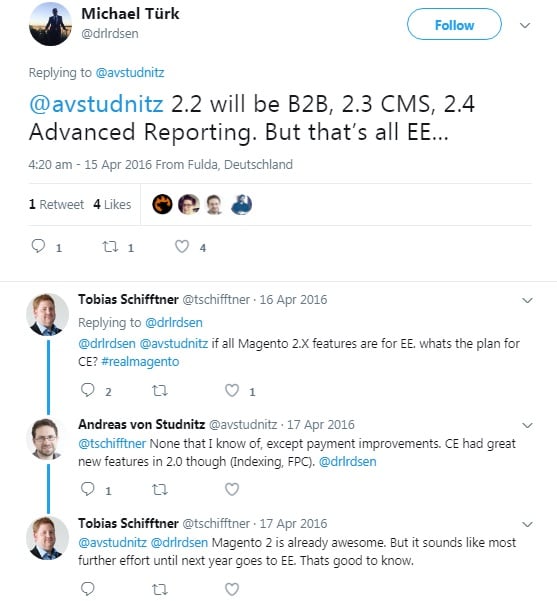
Magento 2.3
Magento 2.3 Beta has been released. Check its features here: Magento 2 Release Notes.
Let’s take a look at the Magento 2.3 roadmap. It includes the following features:
- Business-Friendly Page Builder for the Enterprise version. We already know that it is the Bluefoot CMS. Check these sources: , , .
- Amazon 3rd Party Sales Channel is another vital improvement introduced in Magento 2.3. The source of this rumor is .
- Progressive Web App with the PWA Developer Studio and top-notch client-side performance.
- GraphQL is the new Web API which is extremely flexible and fast in comparison to the current one. The feature is caused by the necessity to implement the PWA model.
- Multi-Source Inventory capabilities will also become a part of Magento 2.3, but the functionality will be limited in comparison to the existing extensions.
- Declarative DB schema + Asynchronous Web API will dramatically improve the way you used to work with Magento.
- Finally, Message Queue is going to become a part of the Open Source edition.
- The same is about the Elasticsearch engine.
- The support for PHP 7.2 will be introduced along with some breaking changes. For instance, Magento will replace mcrypt with libsodium in the future patch version.
- The removal of many Zend framework dependencies should also be a part of Magento 2.3.
- There is also a rumor that Composer package versions will be removed from composer.json.
- WYSIWYG editor should be upgraded as well.
- Early Access Program will be launched for partners
- Fine-grained cache management ACL capabilities will be introduced
- And you won’t need third-party modules for Google reCaptcha and two-factor authentication since Magento 2.3 will support them by default.
Some of these features are described below, but you can find more information here: Magento 2.3 Features.
Previous Rumors and Facts
Magento has already acquired the BlueFoot technology. It is a convenient CMS and page builder module that will become a core part of the Magento platform. On the official BlueFoot website, you can read that it provides convenient tools for managing everything from product descriptions to blogs. Thus, it is fair to assume that Magento 2.3 will get a blog module by default. Follow for further information. You can also read more about Magento 2 BlueFoot integration in .
Klarna integration is another vital Magento 2.3 feature. The service is designed to provide advanced payment options. For instance, it provides the ability to spread the cost of the purchase over time, pay within 30 days after delivery, or pay right away without specifying any additional information except the address. This payment solution is safe and trusted by over 45 million customers. For further information, follow this link: .
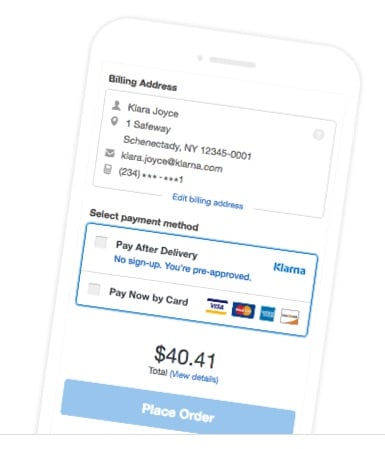
Better API is also among plans for Magento 2.3 release. At least, developers were recently talking about the ORM/Query API. But it is too early to talk about the exact consequences this improvement will move the platform to.
Let’s summarize what we know about Magento 2.3 features. First of all, this platform improvement will introduce better CMS on the basis of BlueFoot. Perhaps, we will even see a blog built into Magento 2.3. Besides, new convenient payment options will be introduced as a Magento 2.3 feature. The integration with Klarna will enable spread payments, payments within 30 days after delivery, and rapid payments with address only. API improvements are planned as well.
Magento 2.4
It seems that many features previously rumored to be a part of 2.4 will be implemented in Magento 2.3. As for Magento 2.4, we should get the following improvements:
- Advanced Reporting – check the source of this feature on ;
- CMS Enhancements – another 2.4 feature mentioned on ;
- Expanded API Coverage – according to , it is the last known feature of Magento 2.4 up to date.
Previous Rumors and Facts
Advanced reporting is planned for Magento 2.4, but we also know that the reporting system of the platform will be improved with Magento 2.2. It seems that the Magento team is not going to stop, so the existing reporting solutions and tools will be improved within several further releases. Today, the difference between the default reporting solution and third-party reports is huge, and finally, the platform will try to close this gap, but will extension providers let this happen? We don’t think so. Indeed, the new platform update will just push the existing third-party reporting tools forward. No additional information is available at the moment.
Other Magento 2.4 features include:
- Planning and early execution by new ATX teams – this should lead to fewer bugs and better user experience;
- Client-rendered frontend framework – also sounds very promising;
- Native PWA (Progressive Web Apps) – Magento 2.4 will include the best of the web and the best of apps;
- – a complete description of the data in Magento APIs that leads to easier APIs evolvement over time and enables more powerful developer tools;
- Internal API usage at 100% – due to the aforementioned feature?
- Advanced extension management and registration – will merchants get more control over modules?
- Entitlement API Apollo
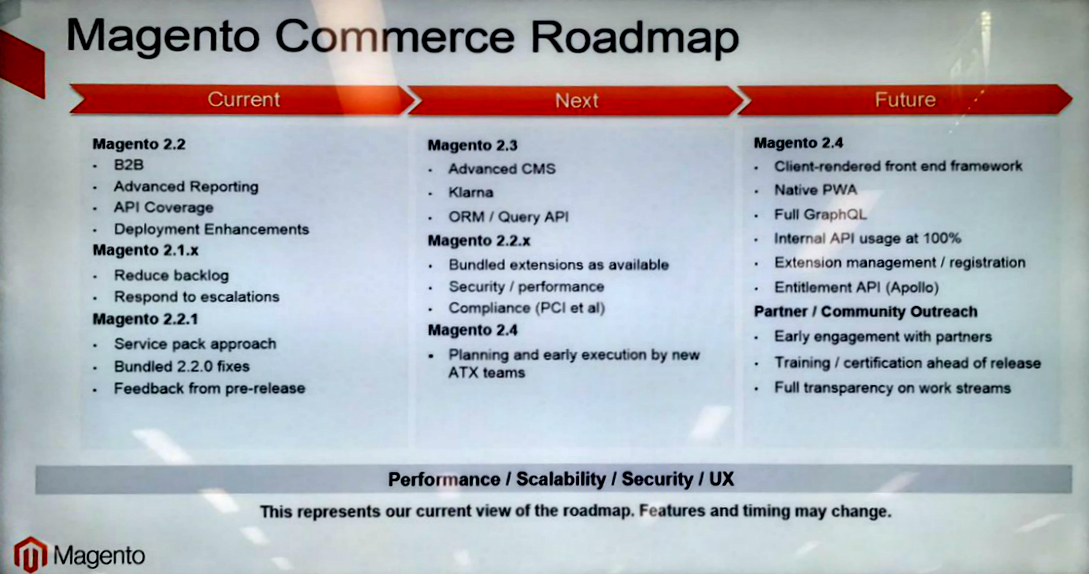
As for the Magento 2.4 features, they will include a better reporting system and essentially improved API usage. Full GraphQL support must be a key enhancement oriented at internal API usage at full capacity.
Magento 2 Roadmap 2017
Magento 2.2
Magento 2.2 will introduce lots of B2B features. Most of them are already available via third-party modules or have an alternative implementation in extensions, but since 2.2 they will become a part of the platform. Note that it is the second attempt to make the platform more oriented towards B2B clients. Earlier this year we’ve already described Magento B2B Commerce Cloud, but it was oriented only toward Enterprise Edition. With 2.2, you will get the following improvements:
- Quote Requests: now your customers will get an opportunity to request discounts and propose their prices right from the shopping cart; quote requests will be available in new backend and customer account areas;
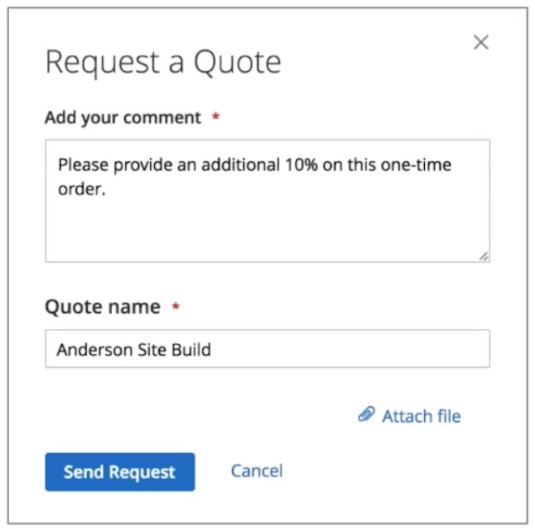
- Fast Purchases: another Magento 2.2 feature is related to the improved shopping experience as well. It allows to combine orders by entering SKUs or uploading a CSV file with SKUs and quantity; it is also possible to create requisition lists like one below:
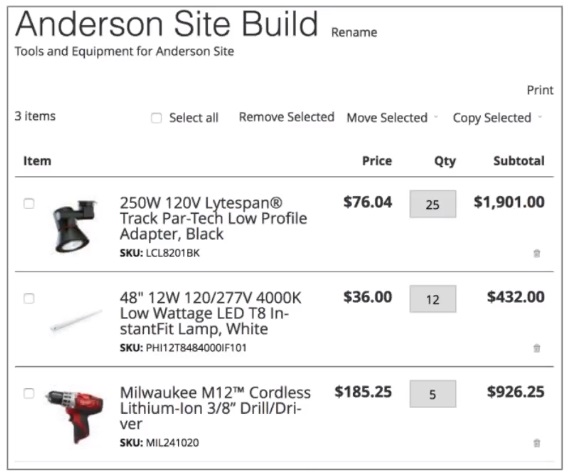
- Account Roles: with Magento 2.2, a corporate customer account can be used by multiple clients representing the company structure; each customer gets his or her unique role;
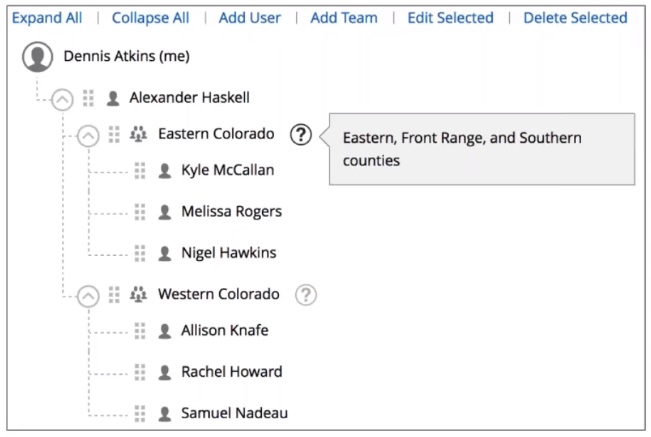
- Payment On Account: you can provide B2B partners with credits; the appropriate payment method will be added to other with the release of Magento 2.2; it is possible to set an individual limit on per client basis;
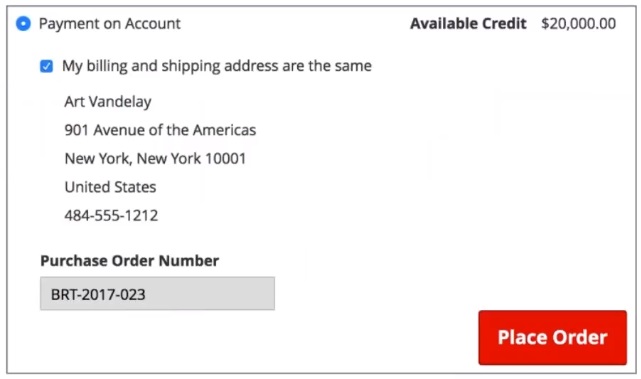
- Customizable Catalog: Magento 2.2 B2B nature also includes customizable price lists and product catalogs; create catalogs with individual selection of products and prices;
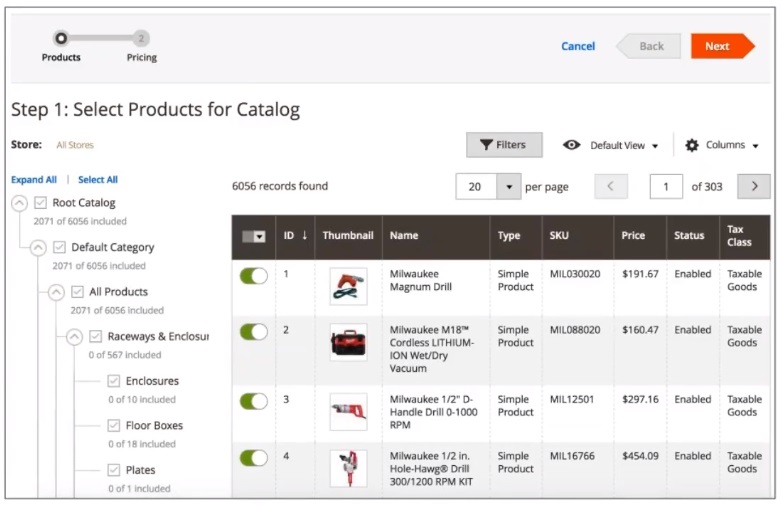
- Advanced Reporting: the first huge attempt of Magento 2 to make default reports better;
- Improved Shipping: it is another new Magento 2.2 feature; the process is more automated and efficient;
- API Coverage: new APIs will be introduced allowing better integration with ERP systems and rapid synchronization with other platforms;
- Magento Social: some social features are also planned, but there is no additional information;
- Magento B2B EE: it seems that Enterprise Edition will get it unique set of B2B features.
The release of Magento 2.2 is expected during September 2017.
Magento 2.2 is totally B2B-oriented. It adds lots of essential B2B improvements to the core. This is a giant step towards making the platform suitable for the needs of B2B clients out of the box. Also, note that some of the aforementioned Magento 2.2 features are going to be enhanced even more during further platform updates.
Magento 2.2.x Features
There are also several vectors in the Magento 2 roadmap that describe further releases of 2.2. They are:
- Bundled extension as available;
- Various security and performance improvements;
- PCI compliance.
Magento 2 Roadmap For Previous Years
Below, you can see all improvements, updates and enhancements that were planned and implemented before. Due to this information, you can always compare different periods in platform development.
2016
Magento B2B
Magento Enterprise B2B tool was planned for Q4/2016 – Q1/2017 and we’ve finally got it in the first half of 2017. Although it was a key step towards B2B functionality, the new tool has one major drawback: it was available for Magento 2 Enterprise Edition only. It was a huge problem, but we’ve created a detailed explanation on how to get all the same B2B features on Magento 2 Community Edition. For further information, follow this link: Magento B2B Commerce Cloud.
Magento 2.1
On 23.06.2016, Magento 2.1 was released. The first major update after 2.0 was published contained lots of Enterprise Edition features and several improvements common for both platforms. For instance, EE users got such new functionality as staging & preview, Elasticsearch integration, and Enterprise Cloud Edition. Besides, PCI compliance was simplified and the admin interface was improved with the release of Magento 2.1. 3 core new features were: Set of PayPal Enhancements, Braintree Hosted Fields, and Improved Management Interfaces. More features are described in Magento 2 Release Notes.
2015
Magento 2 Release
On 17.11.2015, Magento 2.0 was released. It introduced lots of new features and improvements in comparison with the first platform version. Indeed, Magento 2 became absolutely new platform that incorporates some technologies and principles unavailable in Magento 1. We’ve gathered all the information about Magento 2 here: The Ultimate Magento 2 Tutorial.







